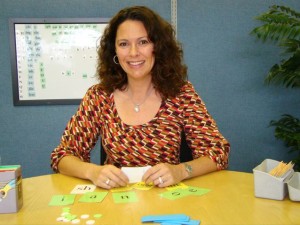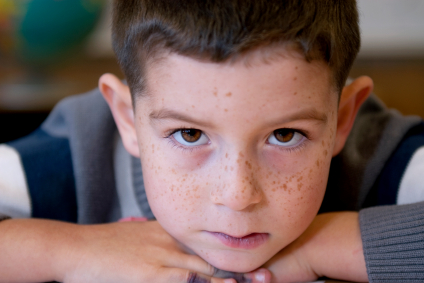
by PRIDE Reading Program Admin | Sep 27, 2015 | A PRIDE Post, Dyslexia
October is National Dyslexia Awareness Month and PRIDE Learning Center will help raise awareness for dyslexia by offering FREE reading assessments throughout the month.
“One out of every ten children has some form of dyslexia,” says Karina Richland, owner of the dyslexia reading centers. “Reading and writing are very difficult for children with dyslexia and these really smart kids end up struggling so much in school.”
PRIDE Learning Center teaches kids with dyslexia how to read and write using a multisensory system called the Orton-Gillingham approach. It is an intensive one-on-one reading program that stresses teaching the entire structure of written English through systemized teaching of letters and their corresponding sounds.
“Most parents don’t even know this type of teaching exists,” says Richland. “This isn’t a brand new program either, the Orton-Gillingham approach to reading has been around since the 1940’s. It is amazing how structured and repetitious it is. Our kids reading skills improve 100% when they come here. It is hard work but we make it really fun and the kids just love coming here.”
Throughout the month of October, parents can bring their children into any local PRIDE Learning Center for a free assessment that will measure their reading abilities. PRIDE Learning Center has locations in Newport Beach, Mission Viejo and San Clemente. To schedule an appointment contact PRIDE Learning Center at 866-774-3342 or visit the website at www.pridelearningcenter.com.

by PRIDE Reading Program Admin | May 7, 2015 | A PRIDE Post, Reading Skills
Getting your child interested in reading is one of the most important things you can do as a parent. I understand it isn’t always easy. Just try to think of your time and energy as an investment in your child’s reading future. Here are some practical tips for getting your child interested in reading…
While there aren’t movie equivalents for every book, there is a large selection of children’s literature out there. If you can find them, watch and discuss them together. Some suggestions are: A Series of Unfortunate Events: Lemony Snicket, Charlie and the Chocolate Factory, To Kill a Mockingbird, Charlotte’s Web, Hoot, etc.
- Find books with cartoons or humor — which only a child would find amusing
Not everything needs to be a learning lesson. Letting children read books such as Big Nate or Diary of a Wimpy Kid will keep them engaged and entertained. Although adults might find the language and humor distasteful, children find it very funny and are therefore more motivated to read.
- Zero in on your child’s passions and choose books and magazines focused on areas of interest
Find books on specific topics to keep your child’s interest, such as science, baseball, American Girl dolls, etc. Children who already have the background knowledge, language and vocabulary before beginning a book will have an easier time getting through the reading. Order a magazine subscription to Sports Illustrated for Kids or Nickelodeon. Children love receiving mail and reading ‘their’ magazines.
- Get your child an email account and, together, check it regularly
Using the computer to read and write is a huge advantage for most students. By letting young children write and send email, they practice reading, writing and spelling. Teach your child how to use spell check before sending off messages. Be sure to monitor your child’s ‘pen pals’ – who is your child writing to and receiving mail from? Let your child pick out a few family members, including grandparents and maybe two or three friends. You will find that by using email regularly, your child becomes very strong in typing (keyboarding) and using the computer.
- Find an author that your child likes and stick with it
If your child loves reading Hank Zipzer by Henry Winkler or Tales of a Fourth Grade Nothing by Judy Blume, then you have found a writing style which stimulates your child’s interest. Go through the entire series. Don’t worry if the reading is below grade level: your child is reading for pleasure and for practice. Also remember, just because you loved a certain author or series when you were a kid, this doesn’t mean your child will love the same books you did. Browse the bookstore or library and find the newest, most modern series. Usually these books contain language and themes to motivate the most reluctant reader. Kids need to relate to what they are reading, and modern language usage helps.
- Get books with large print
For some children with learning difficulties, getting books with larger type can be helpful. Maybe it’s because the pages are less intimidating with less text, or maybe it is the fact that there are fewer words on each line, but it seems to make the reading a bit easier.
- Let your child talk to you about the book they are reading.
When we adults read books we enjoy, we like to talk about them. After reading a book, we don’t necessarily want to write a summary, book report or make a project of it. We just want to discuss it with someone else. Look interested in what your child is reading (yes, even if it is Captain Underpants) and ask questions and have your child tell you about it. Laugh with your child about the funny parts (even at the bathroom jokes) and help your child feel good about reading.
Learn more about the New PRIDE Reading Program
_____________________________________________________________________________________________________________________

Karina Richland, M.A. is the Founder of PRIDE Learning Centers, located in Los Angeles and Orange County. Ms. Richland is a certified reading and learning disability specialist. Ms. Richland speaks frequently to parents, teachers, and professionals on learning differences, and writes for several journals and publications. You can visit the PRIDE Learning Center website at: www.pridelearningcenter.com

by PRIDE Reading Program Admin | Apr 12, 2015 | A PRIDE Post, Dyslexia
Parents are always asking me what they can do to help their dyslexic child. My first response is to most importantly get the child into an Orton-Gillingham program that will give them the necessary skills for reading, writing and spelling improvement. This will need to be done by a trained specialist and should be the number one priority for the dyslexic child.
Keep in mind that the trained dyslexia professional is helping your child by doing the difficult work for you. They are doing reading activities and skill training. It won’t necessarily be for fun and pleasure. So, this is the perfect time that you as a parent get to just read together with your child for fun and pleasure. This is what you the parent can do to give your child the dyslexia help at home they need.
Most likely you will be working with your child after school when they are tired and less receptive to learning and when you, too, are not at your most energetic or patient, therefore, I recommend that you read together with your child for at least thirty minutes each evening making it fun and not a chore for either of you. Evenings spent reading together build a lifelong pattern of enjoyment. A child who avoids reading is among those most in need of practice and guidance, and is especially helped by your reading aloud with him.
When reading for pleasure, allow your struggling reader to relax and listen attentively without being expected to read. You should still encourage your child to sit next to you, so he can see the pages of the book as you read. If you are helping your child with a book that must be read for school, encourage your child to participate by taking turns reading; you can ask your child to read a sentence or a paragraph, then read several paragraphs yourself, then let your child have another turn.
In books with a lot of dialogue, another technique for shared reading is to let your child take the role of one (or more) or the characters, reading the quoted words for that character. This is also a good opportunity to help your child focus on punctuation, such as quotation marks, commas, periods, exclamation points, and question marks. Many children with dyslexia do not understand what punctuation means, and they tend to ignore or disregard punctuation marks when reading because they are so focused on trying to decipher the letters and words. With oral reading, punctuation takes on added significance, as it provides information about when the reader should pause and the intonation that should be used.
When your child is reading aloud, do not interrupt to correct mistakes that do not change meaning, such as reading “mom” for “mother.” Frequent interruptions will cause your child to lose confidence and make comprehension more difficult. If your child stumbles over a word, simply tell her what it is. Do not try to use teaching techniques such as having her sound out words at this time. Instead, enjoy the story together, discuss the plot, and praise your child for her efforts when she reads aloud and is able to figure out some words on her own.
Your child may find it helpful to hold an index card or ruler under each line of text as he reads. This will help him stay focused on the text. It is also possible to purchase a reading guide with a colored filter in the center, which is designed so that your child can move it down the page as he reads.
Some children prefer fiction while others prefer nonfiction. By pairing them, your child will be exposed to both genres. Your child will also love discussing these books together with you.
Because a child with dyslexia needs very individualized and specialized reading help, I recommend that parents become the child’s biggest helper. Teaching a child with dyslexia how to read is a complex task, but with a loving touch and good humor, you the parent can most definitely accelerate your child’s progress.
Learn more about the New PRIDE Reading Program
____________________________________________________________________________________

Karina Richland, M.A. is the Founder of PRIDE Learning Centers, located in Los Angeles and Orange County. Ms. Richland is a certified reading and learning disability specialist. Ms. Richland speaks frequently to parents, teachers, and professionals on learning differences, and writes for several journals and publications. You can visit the PRIDE Learning Center website at: www.pridelearningcenter.com
by PRIDE Reading Program Admin | Feb 6, 2015 | A PRIDE Post, ADHD, Autism
Well, it depends…
The scientific literature abounds with studies claiming to have discovered evidence one way or the other. This often contradictory information can be confusing, but some themes seem to be consistent, and more importantly, to make sense.
For example, there is some correlational evidence that violence in video games may increase aggression in certain vulnerable kids. We believe that kids with excessive anger are attracted to violent games. For these kids, violent games may teach unhealthy conflict resolution skills, glorify aberrant or subversive lifestyles, or desensitize kids to terrible events. Parents should be particularly concerned if a child’s level of aggressive behavior is consistently higher after playing.
On the flipside, there is also evidence that playing video games can act as a healthy outlet for aggressive impulses. Kids who play video games often say that the games help them relax or cope with stress. Violent video games might offer an alternative outlet for aggressive and angry feelings by providing a vicarious, and less destructive, experience of testing limits. In addition, gaming can build self-esteem, provide a sense of accomplishment, and improve socialization. It is unusual, for boys in particular, to not play video games. The shared experience of overcoming certain gaming challenges acts to help some children bond. Game play is often a normal social activity for boys, and lack of interest in social gaming may signal social difficulties.
So if all of this is true, how should parents manage video games in their child’s life? I believe that, for most children, a balanced approach is best. Many kids can use video games in moderation as a healthy tool in their play toolbox. Some children will need their parents to provide structure and moderation for them. For these kids, it is best to make the limits very clear. Parents may want to place a time limit on the game, or a contingency like “you may play for 1 hour after all of your homework and chores are done.” I would also suggest that parents actually play video games with their child. This provides many benefits, not the least of which is forging a stronger bond with your child.
You can also use the time to guide and mentor your child in his or her play. Explain situations or themes that he or she may not understand, or might misinterpret. Use the opportunity to discuss morals and values; parents often underestimate the impact of their words and actions on their child’s beliefs. There are currently several games offering, as a central theme, the moral development of the main character (Fable, Infamous, etc). Use these games as a launching point for discussions about morals.
Playing games with your child also affords you the benefit of a first hand look at the content of your child’s game. Parents can also refer to each games rating from the ESRB (Entertainment Software Rating Board) for a rough guide to a game’s content. Pay particularly attention to games rated “M” as these are intended for people age 17 and above. Your game console, or computer, should have the ability to restrict certain types of games based on that game’s rating.
These suggestions are general, and should work well for most people. For children with significant behavior or emotional problems, the decision to use or exclude video games should be made carefully with attention paid to the potential risks and benefits such a move would have. Allowing the child to use video games, particularly violent games, may increase their aggression, while forbidding the use of their game could remove one of the child’s only sources of self-affirmation and competence.
Some parents have complained to me that their child seems “addicted to their video game”. They spend an excessive amount of time playing alone, and even ignore fun and engaging alternatives. They may not even enjoy playing the game that much, instead they use it to escape from pain or conflict in their lives. In many of these cases, the issue is not the video game itself, but rather the child’s inability to use alternate coping strategies to manage emotional or social problems. If you suspect that your child is suffering from problems like these, I suggest seeking help from a professional in children’s mental health.
Stephen Morris, M.D.
Doctor Morris is an Adult, Child, and Adolescent Psychiatrist operating a private practice in Manhattan Beach, California. For more information, please contact him through his website at https://www.StephenMorrisMD.com

by PRIDE Reading Program Admin | Feb 18, 2014 | A PRIDE Post, Dyslexia
Because dyslexia is primarily associated with difficulty in learning to read, it cannot be reliably diagnosed until your child is the age at which reading typically begins. For most children this happens around the age of six. The following are some common characteristics that may be signs of dyslexia in preschool-age children:
- Jumbling sounds of words in speech, such as saying “pasgetti” for spaghetti” or “mawn lower” for lawn mover.”
- Confusing words signifying direction in space or time, such as “up” and “down,” “in” and “out,” “yesterday” and “tomorrow.”
- Forgetting or confusing the word for known objects, such as “table” or “chair.”
- Delayed speech development.
- Unusual speech patterns, such as frequent hesitations or stammering.
- Difficulty with learning.
- Difficulty remembering and following directions.
- Difficulty learning nursery rhymes and rhyming words.
- Difficulty in learning (and remembering) names of letters.
- Enjoys being read to but shows no interest in letters or words.
- Difficulty with clapping a simple rhythm.
In most cases you will probably not be aware that your child has dyslexia until he is in first or second grade. When reading instruction begins in earnest, your child is likely to lag behind and will begin to show signs of frustration at school. After several months, you may realize that your child simply hasn’t caught on to reading in the same way as his peers. He may still have difficulty recognizing letters of the alphabet, or he may know the letters and their sounds but seem unable to put them together to form even simple words. You may notice that he seems unable to remember words that he has seen before and struggles to sound out every word he sees.
The surest sign of dyslexia is simply the fact that your child seems bright and capable at home and at play, yet he struggles with reading, writing, and spelling. School-aged children with dyslexia will exhibit many of the following symptoms:
- Confusing letters with similar appearances, such as “b” and “d” or “e” and “c.”
- Writing that contains frequent reversals, transpositions, or inversions.
- Difficult remembering common sight words, even after repeated practice.
- Stumbling, hesitating, or making mistakes or omissions when reading small, easy words like “and” or “from.”
- Spelling phonetically and inconsistently such as writing “foniks” for “phonics” or “skul” for “school.”
- Complaining of dizziness, headaches, or stomachaches while reading.
Your first indication that something is wrong may be complaints from your child’s teacher about his behavior and problems he is experiencing at school. Many behavior problems stem from the dyslexia itself; your child’s teacher may complain that he doesn’t pay attention or follow directions, or that he is slow to complete class work. These issues may be the direct result of your child’s confusion and inability to understand much of what is going on around him. Other behavior problems may be deliberate and could be an expression of his frustration and anger; he may intentionally try to disrupt the class to create distractions so as to avoid having to complete his work. He would rather be known as the class clown than the class “dummy.” He may even want to incur punishment, if punishment means being sent to sit in the hallway or principal’s office. To a child with dyslexia, such punishment can be a welcome reprieve from the torture of the classroom. Some common behavior problems that your child’s teacher may report are:
- Laziness, carelessness, or immaturity
- Daydreaming
- Disruptive behavior
- Being easily distracted
- Resistance to following directions
- Reluctance to work on assignments
If you suspect that your child has dyslexia, you will want to seek testing and a diagnosis. Diagnostic testing will help you better understand your child and may guide you to make better choices. Ideally, testing should give you a map of your child’s strong and weak points, and a set of recommendations as to how best to meet his educational needs.
_________________________________________________________________________________________________________
Karina Richland, M.A. is the Founder of PRIDE Learning Centers, located in Los Angeles and Orange County. Ms. Richland is a Certified reading and learning disability specialist. Ms. Richland speaks frequently to parents, teachers, and professionals on learning differences, and writes for several journals and publications. You can visit the PRIDE Learning Center website at: www.pridelearningcenter.com






